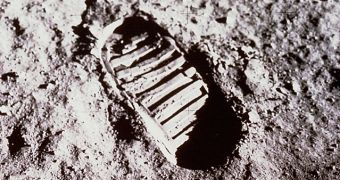Extremely fine, like flour, but still sandpaper-rough, moon dust infiltrates the astronauts' spacesuits, causing "lunar hay fever," and creates dust storms within the shuttle cabins.
All of the Apollo missions that took place between 1969 and 1972 reported the same major problem: lunar dust. As professor Larry Taylor, Director of the Planetary Geosciences Institute at the University of Tennessee relates: "The major issue the Apollo astronauts pointed out was dust, dust, dust." Taylor and some of his fellow researchers will share their studies on this topic during the the "Living on a Dusty Moon" session which will be held on Thursday, October 9, 2008, at the Joint Meeting of the Geological Society of America (GSA), Soil Science Society of America (SSSA), American Society of Agronomy (ASA), Crop Science Society of America (CSSA), and Gulf Coast Association of Geological Societies (GCAGS) in Houston, Texas. The main purpose of this meeting is to aid NASA on planning the next manned moon mission in 2018 more thoroughly and carefully. Furthermore, Taylor will also speak on "Formation and Evolution of Lunar Soil from An Apollo Perspective."
The lunar dust is formed during micrometeoritic collisions that shatter the satellite's rocks into very tiny particles. The energy of this process melts them into vapors which then condense on particles of soil upon cooling, conferring the sand its glassy touch and aspect. During the mission of Apollo 17, "The dust was so abrasive that it actually wore through three layers of Kevlar-like material on Jack’s [Harrison "Jack" Schmitt] boot," Taylor says. Even worse, electrons in the dust are driven out by the ultraviolet rays during the day, but when nighttime comes, the solar wind throws them back in. This phenomenon causes the dust particles to become super-charged electrically, and, when trying to be removed from a visor or a lens, for example, they only stick harder to it.
Also, the moon dust particles contain microscopic metallic iron specks (FeO), which makes them susceptible to the influence of magnets. Based on this feature, Taylor designed magnetic filters to clean the air, as well as "dust suckers," a kind of vacuum cleaners with magnets instead of the vacuum. But the iron in the dust proves to be health-threatening. According to NASA’s Johnson Space Center's Bonnie Cooper, "Those tiny blebs of pure iron we see on the surface of lunar grains are likely to be released from the outside edges of the particle in the lungs and enter the bloodstream." This impact is currently under study and will result in a standard regarding lunar dust exposure in 2010.
Meanwhile, Taylor found that microwaves manage to melt the moon soil very fast. Based on this aspect, he dreams of creating a vehicle that would use the microwave melting technique in order to create roads or lunar landing pads. Similarly, he plans to develop a tool that would melt the soil on the lunar modules, providing insulation against the radiation from the outer space, also emanating breathable oxygen during the heating process.

 14 DAY TRIAL //
14 DAY TRIAL //